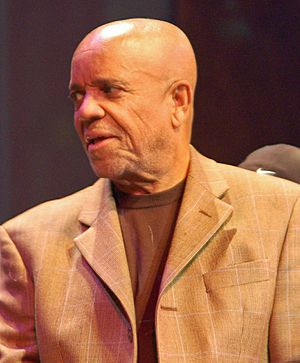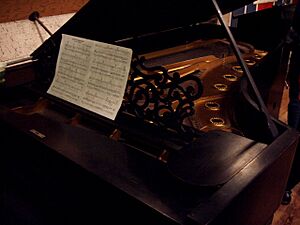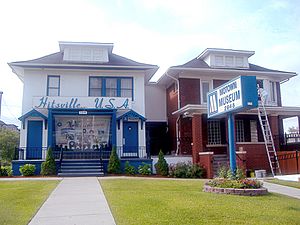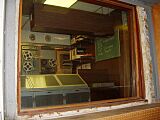Hitsville U.S.A. facts for kids
Hitsville U.S.A. is the special name given to the very first main office and recording studio for the famous music company, Motown. This building, which used to be a photographer's studio, is located at 2648 West Grand Boulevard in Detroit.
The founder of Motown, Berry Gordy, bought this house in 1959. He changed it into a place where the record label could have its offices and record music. Motown became super successful from the mid-1960s to the mid-1970s. After that, Berry Gordy moved the company to Los Angeles. There, he created a new studio called Hitsville West, which worked on TV shows, movies, and music.
Today, the original "Hitsville U.S.A." building is the Motown Museum. This museum celebrates the amazing history of the record label, its artists, and their music. The museum uses the first house and another house next to it.
Contents
Motown's First Home

In 1959, Berry Gordy started his first record label, Tamla Records. He then bought the property that would become Motown's Hitsville U.S.A. studio. The photography studio at the back of the property was changed into a small recording studio. This studio was open almost all the time, 22 hours a day! It only closed for two hours in the morning for cleaning.
The Gordy family lived on the second floor of the house. Within just seven years, Motown grew so much that it took over seven more houses nearby. Each house had a special job:
- Hitsville U.S.A. (1959): The ground floor had offices, a tape library, the control room, and Studio A. The top floor was where the Gordy family lived until 1962. After that, it became the office for artists and their music (called artists and repertoire).
- Jobete Publishing office (1961): This office handled sales, bills, money collection, shipping, and talking to the public.
- Berry Gordy Jr. Enterprises (1962): This was where Berry Gordy Jr. and his sister, Esther Gordy Edwards, had their offices.
- Finance department (1965): This team managed money, including paying artists their royalties and handling payroll.
- Artist personal development (1966): This important section helped artists grow. Harvey Fuqua led this team and helped with stage performances. Maxine Powell taught artists how to look good, act gracefully, and behave well. Maurice King was a vocal coach and music director. Cholly Atkins created dance moves for the artists. There were also rehearsal studios here.
- Two houses for administrative offices (1966): These houses were for sales, marketing, travel, and mixing and mastering music.
- ITMI (International Talent Management Inc.) office (1966): This office handled artist management.
By the end of 1966, Motown had more than 450 employees. The company was earning a lot of money, showing how successful it had become.
Growing and Moving
In 1967, Berry Gordy bought a large house in Detroit's Boston-Edison Historic District to be his new home. He let his sister Anna and her husband, Marvin Gaye, live in his old home. Pictures for Marvin Gaye's famous album What's Going On were taken there.
In 1968, Gordy bought the Donovan building in Detroit. Motown's Detroit offices moved there. (The Donovan building was taken down in 2006 to make parking for a big sports event). In the same year, Gordy bought Golden World Records. Its recording studio became Motown's Studio B.
In 1972, Berry Gordy moved Motown Records' main office to Los Angeles. The original Hitsville studios, which had created so many worldwide hit songs, became the Motown Museum. The next year, he changed the company's structure. It became Motown Industries, a huge entertainment company that included music, movies, TV, and publishing. Many Motown fans felt that the company's heart and soul were left behind after the move. They believed its most creative time ended after 13 years in Detroit. Esther Gordy Edwards chose not to move to California. She was put in charge of what was left of Motown's Detroit office in the Hitsville building.
The Motown Museum Today
Esther Gordy Edwards often received requests from people who wanted to visit the Hitsville building. She and her secretary put up posters and gold records. She also carefully kept Studio A just as it was. Since 1985, the Hitsville U.S.A. building has been the Motown Museum. It is dedicated to the amazing history of the record label, its artists, and their music.
On October 23, 1988, Michael Jackson visited the museum. He gave them a black fedora hat and a white glove with studs. He also donated $125,000, which was all the money from the first show of his Bad World Tour. Esther Edwards' granddaughter, Robin Terry, is now the board chair and CEO of the museum.
Three of the original Motown houses are used by the Motown Museum. Hitsville U.S.A. and the Jobete office are connected. They hold exhibits with costumes, photos, and records from Motown's most successful time. You can also see Motown's Studio A and Berry Gordy's apartment upstairs, decorated to look just like they did in the 1960s. The finance department building is now an administrative office. The part of West Grand Boulevard where the museum is located was renamed "Berry Gordy, Jr. Boulevard." The museum is one of Detroit's most popular places for tourists to visit.
In October 2016, the museum announced a big plan to expand. They wanted to spend $50 million to create more space for interactive exhibits and recording studios. Since this announcement, the museum has received donations from groups like The Kresge Foundation and the W. K. Kellogg Foundation to help with the expansion and community programs.
Motown's Special Piano

The Motown piano is a very old and special grand piano made by Steinway & Sons in 1877. Many musicians, including the famous studio band The Funk Brothers, used this piano at Hitsville U.S.A. Studio B from 1967 to 1972.
On July 24, 2011, Paul McCartney was in Detroit for a concert. He visited the Motown Museum for a private tour. While in Studio A, he wanted to play the Motown piano, but it wasn't working. Paul McCartney helped pay for the piano to be fixed by Steinway & Sons in 2012. Later that year, he and Berry Gordy played the restored piano together at a charity event.
Motown got this piano when it bought Golden World Records in 1967. The Golden World studio then became Hitsville U.S.A. Studio B. Today, the piano is on display in Studio A at the Motown Museum.
Motown Music Collections
In 1992, Motown released two large music collections on CD. These sets included many hit songs from different periods. One set, called Hitsville USA: The Motown Singles Collection 1959–1971, had 104 songs from the "Detroit era." The other set, Hitsville USA: The Motown Singles Collection Volume 2 1972–1992, had 76 songs from the "Los Angeles era."
See also
- List of music museums
- Berry Gordy
- Esther Gordy Edwards
- Motown
- Music of Detroit
- The Funk Brothers
- Hitsville U.K.





